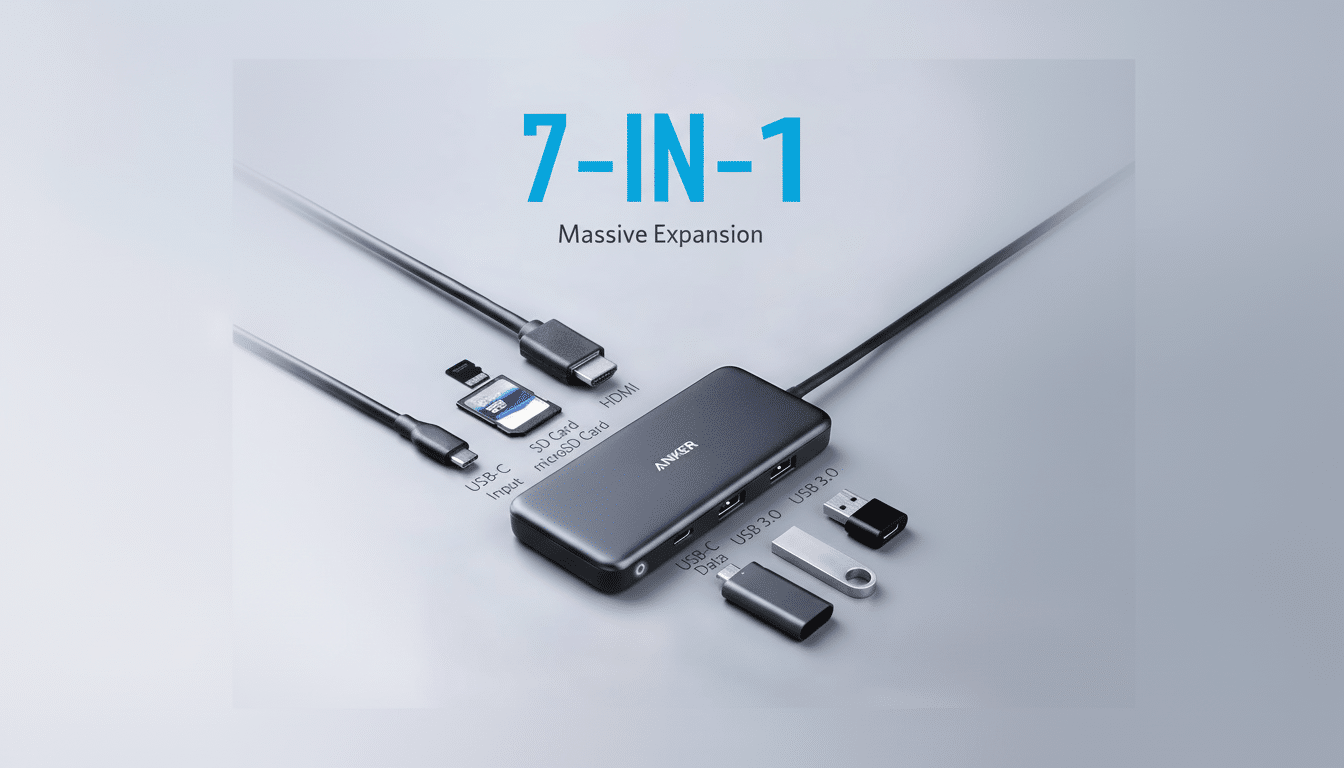An uncommon discount has taken the popular Anker 7‑in‑1 USB‑C hub down to $29.99, a 25% reduction from its typical price of $39.99.
For anyone who’s watched their sleek laptop lose its last port the moment someone said “And now let’s start the meeting,” this is a great opportunity to add versatility without adding bulk or cost.

Why this price cut matters for travelers and students
Seven‑port hubs from reputable brands typically cost between $40 and $70, though comparable models from the likes of Belkin and Satechi are often more expensive. At $29.99, this model steps ever so slightly into budget‑model territory while retaining features that frequent travelers and hybrid workers will actually use. Here at this price point the aluminum chassis is a standout, providing more durability and better heat dissipation than the typical plastic shells of competitors in the sub‑$30 space.
It also holds an average rating of around 4.5 stars from buyers at top retail sites, so it seems reliable in everyday use as well. In a peripheral category where bad cables or flaky HDMI out can quickly pile up poor ratings, sustained high ratings are a useful signal.
What you get in the 7‑in‑1 design and port layout
The hub incorporates a 4K HDMI port; three 5Gbps data ports, consisting of one USB‑C and two USB‑A; an SD card slot; gig‑ready wired Ethernet; and a pass‑through USB‑C input for power. The 5Gbps ports are in the ballpark of USB 3.2 Gen 1 speeds, which tend to transfer files at actual speeds of some 300–400MB/s, which can vary depending on drive and host. That’s more than enough for SSD enclosures, webcams and capture dongles all running at the same time.
The HDMI output is 4K compatible at a 30Hz refresh rate, great for productivity displays. If you’re looking to do high‑frame‑rate gaming or 4K60 video editing on an external screen, then you’ll want a hub or dock that advertises HDMI 2.0 or DisplayPort 1.4 bandwidth. For spreadsheets, timelines, dashboards and browser tabs, 4K30 makes for a useful power‑efficient pairing.
Pass‑through charging (capable up to 85W) is a useful addition. That’s more than enough to keep an ultrabook with a half‑dozen Chrome browser tabs open, or your average MacBook Air, Dell XPS 13 and Lenovo ThinkPad X1 running comfortably under typical multitasking. It’s also capable of sustaining a 14‑inch MacBook Pro through lighter to moderate workloads, though the peak charging rates for larger workstations will continue to outstrip an 85W power input. According to the USB Implementers Forum, Power Delivery can support up to 100 W on generic cables, shading just under that top end you often see with compact travel hubs.
Real‑world use and everyday performance notes
Setup is plug and play on most Apple, Lenovo, HP or Dell laptops or tablets (as well as the majority of Chromebooks), so there’s no need to even hunt for drivers. The HDMI connector ensures your USB‑C device has a full‑size HDMI port via USB‑C video output. Phones and tablets vary; a lot of top‑end ones do, but it’s something to check if in doubt on your model.

For artists and students, the SD card slot allows for quick photo transfers from cameras or drones. The listing says UHS‑I class performance, but that still means up to 104MB/s in perfect conditions—more than enough for shuttling RAW photo sets around or even proxy files for 4K footage. Combine that with wired Ethernet and you have consistent upload speeds for cloud backups or conference calls that don’t break up when the Wi‑Fi traffic gets heavy.
Cable clutter is yet another silent victory. One USB‑C cable back to the laptop can provide power, display, storage and a webcam, transforming a kitchen table into a workable desk that recalibrates in seconds. That single‑plug workflow is a big reason travel hubs continue to be popular, even as laptops gain a few additional ports each generation.
How it compares with rivals in price and features
Against the field of high‑end Thunderbolt 4 docks, some of which can exceed $200, this hub is aiming at a different kind of use case: portable expandability at a certain bandwidth, not complete maximum throughput. Don’t plan on having dual 4K60 displays or PCIe‑class bandwidth. But it’s priced at $29.99, and you are getting a known brand name, 85W pass‑through and a pragmatic blend of ports that address the majority of daily needs.
Shoppers can frequently find similar hubs for less that forgo Ethernet, pare back to two data ports or use plastic shells. But midrange models in the $50–$70 range may add 4K60 video, or microSD alongside SD. This Anker model hits that sweet spot of office, study and travel without including any niche features that most people wouldn’t use.
Who should buy this hub and the key caveats to know
If your setup is one laptop, one external monitor and a couple of USB peripherals (all powered to the max), see if you can resist this deal. For remote workers hopping from room to room, students living out of a backpack or photographers who are looking for convenient SD access and a reliable wired network on the road, it’s an easy upgrade.
Before you check out, a couple of caveats: You’ll have to provide the USB‑C charger that feeds the hub’s power input; and 4K30 resolution requires a video‑capable USB‑C port on the host. With all of those boxes checked, $29.99 is an unusually good deal for a 7‑port metal hub including 85W pass‑through and plenty of proof that customers are in good hands.

